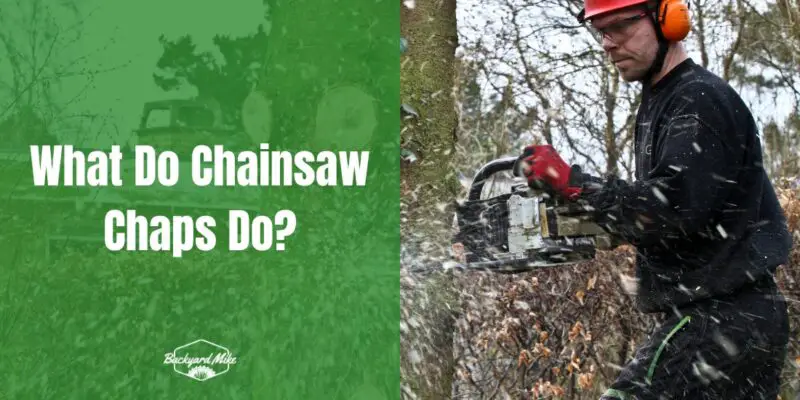Chainsaw chaps protect you by acting as a barrier against potential chainsaw injuries. Made with strong materials like Kevlar and ballistic nylon, they quickly stop the chainsaw chain if it makes contact, reducing the risk of severe cuts. Their open-back design guarantees comfort and ventilation. Essential for both beginners and occasional users, they help keep you safe during landscaping or farm tasks. To know more about safety measures and practical use, explore further.
Key Takeaways
- Chainsaw chaps use protective fabric to catch and stop chainsaw strands, minimizing potential injury.
- They incorporate robust materials like Kevlar to quickly halt the chainsaw's cutting action.
- The fiber clogging mechanism jams the chainsaw chain, preventing severe cuts.
- Chainsaw chaps comply with safety standards, reducing the risk of serious injuries.
- They offer essential protection during chainsaw use, especially for beginners and infrequent users.
Key Features of Chainsaw Chaps
Chainsaw chaps have several key features designed to protect you during chainsaw operations. They work by catching the long strands of protective fabric in the chainsaw's chain, halting its movement and reducing the risk of severe injuries. This protective design minimizes potential cuts, making chainsaw chap benefits clear: they could prevent life-altering incidents. Worn over your clothing, these chaps offer ventilation since they're open at the back, ensuring comfort while you work. They're easy to remove when not needed, making them convenient for shared use among crew members. Plus, their lower purchase cost compared to chainsaw pants makes them an economical choice. Compliance is straightforward, as their use can easily be verified during drive-by inspections, ensuring safety standards are met. Chainsaw chaps are ideal for occasional chainsaw work, providing effective protection without the need for constant wear and removal.
Materials Used in Chainsaw Chaps
When choosing chainsaw chaps, you should consider materials like ballistic nylon and Kevlar for their exceptional benefits. Ballistic nylon enhances the chaps with strength and abrasion resistance, while Kevlar adds cut resistance and durability. Additionally, the fiber clogging mechanism in these materials is essential, as it helps stop the chainsaw chain by jamming the fibers, ensuring your safety during operation. Many regions have specific chainsaw safety regulations, making it important to select chaps that comply with these standards to avoid fines or penalties.
Ballistic Nylon Benefits
Ballistic nylon is an essential material used in chainsaw chaps, offering significant benefits for durability and safety.
As a key component of your protective gear, it enhances the strength and resistance to cuts, guaranteeing you remain safe during challenging tasks. This material is woven to withstand chainsaw impacts, reducing the severity of potential injuries. Its exceptional cut resistance prevents deep wounds by stopping cuts from spreading. Furthermore, ballistic nylon is known for its durability and longevity, resisting abrasion and harsh environmental conditions like rain and snow. You'll find it maintains its protective qualities over time, making it a reliable choice for forestry and logging work. Plus, its comfort and practicality guarantee you can move easily while staying protected. Additionally, ballistic nylon meets various certification standards, ensuring it offers verified protection. Defender PRO Arborist Chainsaw Chaps also utilize an oil and water-resistant coating, adding an extra layer of protection against environmental elements.
Kevlar Strength and Durability
Kevlar offers exceptional strength and durability, making it an essential material in chainsaw chaps. As a synthetic aramid fiber, Kevlar has a storied history of providing high cut-resistance and flame resistance, vital in dangerous environments.
You'll find Kevlar in various applications, from protective gear to aerospace, due to its impressive material properties. Chainsaw chaps use multiple layers of Kevlar, enhancing protection against accidental cuts. These chaps are also constructed with Cordura for added strength, ensuring that they remain durable during forestry and logging activities.
It's paired with materials like Cordura nylon for added durability, guaranteeing you stay safe while working. Kevlar's high abrasion resistance and ability to withstand environmental challenges make it a reliable choice.
Regular inspections and proper care, such as avoiding harsh chemicals, guarantee long-term protection. Remember, Kevlar chaps comply with stringent safety standards.
Fiber Clogging Mechanism
Although chainsaw chaps might seem simple, their fiber clogging mechanism plays an essential role in your safety. When a chainsaw contacts your chaps, fiber engagement occurs as the cut-resistant fibers are drawn into the drive sprocket. This stops the chain almost immediately, preventing severe injuries. The reduction in chain speed further enhances this protective effect. Specially designed material clogs the sprocket upon contact with the chainsaw, effectively reducing injury risk and severity. Modern materials like UHMWPE, found in fabrics such as Arrestex HP, provide high cut resistance and strength, ensuring effective clogging. Unlike traditional nylon or polypropylene, these advanced fibers allow for thinner, lightweight designs without compromising protection.
With the right materials and proper maintenance, your chaps can offer reliable safety and comfort, keeping you secure and part of a community that values safety first.
How Chainsaw Chaps Protect You
When you're using a chainsaw, wearing protective chaps is essential because they act as a barrier against potential injury.
As part of your safety gear, chaps are designed for injury prevention by integrating robust materials like Dyneema fibers and Kevlar. These fibers are engineered to engage with the chainsaw's mechanism instantly. When the outer layer is cut, long, loose fibers are drawn out, wrapping around the chain's drive sprocket, effectively halting it. This quick blocking action can prevent severe cuts, providing critical protection. Chainsaw protective clothing, such as chaps, must comply with specific safety standards to ensure they offer adequate protection against chainsaw cuts.
Engtex's Verdict and Avertic fabrics enhance this process with their advanced cut resistance and washability. By complying with strict standards, these chaps guarantee you're safeguarded, making them an indispensable part of your protective gear.
Situations Requiring Chainsaw Chaps
When you're working in environments where chainsaw use is essential, like forestry or landscaping, chainsaw chaps are a must-have for safety. Even if you're a homeowner using a chainsaw occasionally, wearing chaps can greatly reduce the risk of injury. Chainsaws can pose significant risks, including unexpected kickbacks, making proper protective gear essential. Their practicality and ease of use make them ideal for situations where chainsaws aren't used constantly but safety is still a priority.
Essential Work Environments
In various work environments, chainsaw chaps are essential to guarantee safety when operating a chainsaw. In logging and forestry, where logging safety is paramount, chaps protect you from the constant chainsaw risk. They're a must-have for creating a safe workspace. Similarly, in agricultural settings, chainsaw chaps offer critical agricultural protection. Whether you're clearing brush or maintaining land, chaps shield you from potential injuries. On construction sites, they provide an added layer of safety for workers handling chainsaws. Wildfire management teams also rely on chaps when combating fires, ensuring their safety amidst challenging conditions. Chainsaw chaps are constructed from cut-resistant material, which helps stop the chainsaw chain from moving and minimizes the extent of injuries in case of an accident.
Occasional Chainsaw Use
Although you might only use a chainsaw occasionally, wearing chainsaw chaps is essential for safety. They provide critical protection for homeowners tackling infrequent tasks or farm work like clearing fallen trees. Chainsaw chaps are cost-effective, offering injury prevention without the expense of full chainsaw pants. They can be shared among crew members and are easy to put on and take off, making them perfect for intermittent use.
- Landscaping Tasks: Ideal for sporadic chainsaw tasks.
- Homeowner Use: Offers convenience and cost-effectiveness.
- Farm Work: Provides sufficient protection without needing full pants.
For homeowners using chainsaws, consideration for beginners is crucial to ensure safe and efficient operation. Chainsaw chaps feature inner materials that can entangle the chainsaw chain, reducing potential injuries. As cut-resistant safety chaps, they are designed to reduce the risk of injury but are not entirely cut-proof, so proper fit and maintenance are crucial.
Prioritize chainsaw safety by ensuring your chaps fit properly and meet safety standards.
Chainsaw Chaps Versus Chainsaw Pants
Choosing between chainsaw chaps and chainsaw pants requires understanding the distinct benefits each offers.
Chaps advantages include cost-effectiveness and shared responsibility, making them popular in team settings. They're cheaper, easy to put on and off, and have an open-back design for ventilation, which is great in hot conditions.
However, pants disadvantages are notable, especially when considering cost and portability. Chainsaw pants, while more expensive, provide all-day wear without needing adjustment, ensuring consistent safety compliance and movement. They don't snag on equipment and offer a professional appearance. Industry standards dictate that both chainsaw chaps and pants are certified to the same level of protection, ensuring safety across different preferences.
But, pants require individual maintenance and aren't as easily shared. For brief tasks, chaps are practical, but for extended use or climbing, pants might be the better choice.
Essential Safety Considerations
When deciding between chainsaw chaps and pants, it's important to understand the vital safety measures required when using a chainsaw. Chainsaw injuries are alarmingly common, with around 30,000 serious incidents annually. Adhering to safety regulations and using proper PPE is essential. Chainsaw chaps are necessary for protecting your legs from kickbacks and accidental cuts. They meet OSHA standards, offering a reliable defense. Chainsaw chaps are made of durable nylon, which is resistant to wear and tear, ensuring they provide long-lasting protection during outdoor use. Additionally, chainsaw chaps often have an anti-kickback feature that reduces the risk of sudden movements that could lead to accidents.
- PPE Essentials: Always wear hard hats, eye protection, hearing protection, and cut-resistant safety chaps.
- Regular Inspections: Check chainsaws for proper chain tension, oil levels, and functioning brakes/throttle.
- Proper Techniques: Maintain a balanced stance, use correct cutting methods, and keep the saw below shoulder height.
These practices help guarantee your safety in the community of chainsaw users.
Frequently Asked Questions
How Do You Properly Fit and Wear Chainsaw Chaps?
So you're a chainsaw artist now? Well, don't skip on chainsaw chap fittings. Make certain proper chap adjustments by buckling all straps snugly, covering past the boots. Secure fitting guarantees you belong to the safe woodcutter's club!
Are Chainsaw Chaps Reusable After a Chainsaw Strike?
You can't reuse chainsaw chaps after a strike because their durability is compromised. Always inspect your chaps for damage and follow maintenance tips to stay safe. Being part of a safety-conscious community keeps everyone protected.
Do Chainsaw Chaps Protect Against Electric Chainsaws?
You're probably wondering if chainsaw chaps protect against electric chainsaws. They do! Advanced materials like Arrestex HP enhance electric chainsaw safety, ensuring your chainsaw safety gear protects you, helping you feel secure and part of a safe work environment.
Can Chainsaw Chaps Be Altered or Customized for Better Fit?
Did you know 40% of chainsaw injuries affect the legs? You can explore customization options like fit adjustments for chainsaw chaps. Adjust straps for comfort, ensuring safety and belonging as you tackle tasks confidently together.
How Should Chainsaw Chaps Be Stored When Not in Use?
You should store chainsaw chaps in cool, dry storage conditions, avoiding direct sunlight and extreme temperatures. Maintain them by hanging them up, not folding, and using breathable bags. These maintenance tips guarantee they stay effective and ready.
Conclusion
In summary, always wear chainsaw chaps when operating a chainsaw to protect yourself from potential injuries. These chaps, made from durable materials, are essential in deflecting chainsaw cuts, giving you a vital layer of safety. Remember, whether you're a professional or a DIY enthusiast, the risk is real. Chainsaw chaps act as your barrier against danger, reducing the chance of severe harm. Equip yourself properly and stay safe, because safety shouldn't be an afterthought—it should be your first priority.


